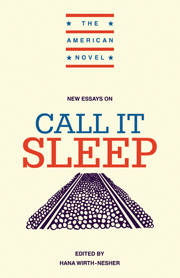Book contents
- Frontmatter
- Contents
- Series Editor's Preface
- Dedication
- 1 Introduction
- 2 The Many Myths of Henry Roth
- 3 Shifting Urbanscape: Roth's “Private” New York
- 4 The Classic of Disinheritance
- 5 Henry Roth in Nighttown, or, Containing Ulysses
- 6 Roth's Call It Sleep: Modernism on the Lower East Side
- 7 “A world somewhere, somewhere else.”
- Notes on Contributors
- Selected Bibliography
- Plate section
5 - Henry Roth in Nighttown, or, Containing Ulysses
Published online by Cambridge University Press: 05 June 2012
- Frontmatter
- Contents
- Series Editor's Preface
- Dedication
- 1 Introduction
- 2 The Many Myths of Henry Roth
- 3 Shifting Urbanscape: Roth's “Private” New York
- 4 The Classic of Disinheritance
- 5 Henry Roth in Nighttown, or, Containing Ulysses
- 6 Roth's Call It Sleep: Modernism on the Lower East Side
- 7 “A world somewhere, somewhere else.”
- Notes on Contributors
- Selected Bibliography
- Plate section
Summary
Literary history, in its collective wisdom, seems to have settled on a descriptive epithet for Call It Sleep. Roth's novel, we have grown accustomed to hearing, is “Joycean.” Robert Alter has described it as “together with The Sound and the Fury … the fullest American assimilation of Joyce” (1988: 34; see also Alter 1994: 3). The Columbia History of the American Novel, speaking with the voice of canonical authority, pronounces it “arguably the most Joycean of any novel written by an American” (Elliott 1991: 394–395). Roth's aesthetic kinship with Joyce was noticed as early as 1935 by the novel's first reviewers (see Ribalow 1960: xii–xiv). Roth himself has gone on record as acknowledging Joyce as his “master” in matters of novelistic technique, while simultaneously repudiating the creative cul-desac into which, he alleges, Joyce's aesthetic ideology led him (Roth 1987: 189, 266–267 and passim). Nevertheless, although many commentators have applied the “Joycean” epithet to Call It Sleep – usually honorifically, occasionally not – few have taken it seriously enough actually to explore the relationship (if any) between Roth's poetics and Joyce's.
Robert Alter is one of the rare exceptions to this general pattern. In an exemplary review article of 1988, he juxtaposed passages from Joyce and parallel passages from Call It Sleep with a view to substantiating the alleged “Joycean” qualities of Roth's novel. Alter recognizes the presence of both the earlier Joyce of A Portrait of the Artist as a Young Man and the later Joyce of Ulysses in Roth's text, but, he contends, it is especially the technique of A Portrait of the Artist that pervades Call It Sleep (1988: 34).
- Type
- Chapter
- Information
- New Essays on Call It Sleep , pp. 75 - 106Publisher: Cambridge University PressPrint publication year: 1996
- 1
- Cited by

